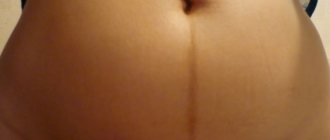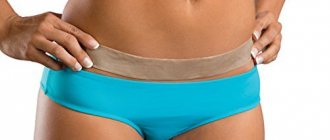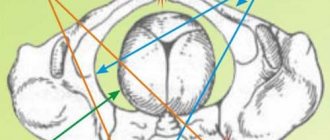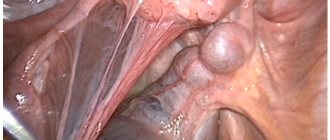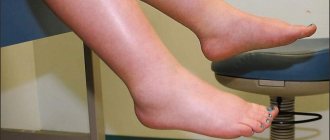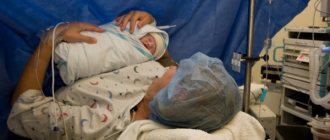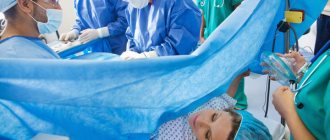Why does headache appear and how is it treated after childbirth?
Bloating and constipation, a painful stomach, are associated both with pressure on the intestines during childbirth, and with subsequent contractions of the uterus and its effect on the digestive organs.
Abdominal numbness, which mothers often complain about after childbirth, is caused by damage to nerve endings during surgery. Headache during epidural anesthesia occurs much less frequently than after a spinal block or spinal puncture, but the pathogenetic mechanisms of these manifestations are similar. Through the damaged area of the dura mater, a slow flow of cerebrospinal fluid occurs from the subdural space into the epidural space.
Normally, cerebrospinal fluid performs several functions:
- protects the brain from mechanical damage and irritation when moving the head and body;
- trophic – participates in the metabolic processes of tissues of the brain and spinal cord;
- participates in the regulation of intracranial pressure.
A decrease in the amount of cerebrospinal fluid causes a compensatory dilation of cerebral vessels - this is the first explanation for why a headache occurs. Due to insufficient pressure, the barrier function is also not performed, therefore, with sudden movements of the head or changes in body position, the brain is displaced, and the irritation of sensitive receptors that occurs in this case is the second possible explanation.
Pregnancy and childbirth are positive, but still stressful for a woman’s body. This period in the life of every girl requires tension in the work of many systems and organs. And after the baby is born, the problems only begin: sleepless nights, lack of time, worries, etc. Often women note that a headache appears after childbirth. What could this be connected with, how can I get rid of such an unpleasant condition?
Read in this article
Pain a month after cesarean
It should be remembered that a caesarean section, although intricate and not so complicated, is still an operation. This means that after surgery you will have to take care for some time, and some discomfort in the first few days in the form of painful sensations cannot be avoided.
The greatest inconvenience in this regard to a woman is caused by the suture itself and the area around the incision. Since the tissues were artificially cut, there will be pain in the area of the incision for several days. To avoid severe pain, the woman is prescribed painkillers from the first day immediately after surgery. By day 4-5, the regimen for taking analgesics is reviewed, then, over time, as the body recovers, their prescription is gradually abandoned.
By the end of the first month, most women, if they follow all the recommendations related to the postoperative period, may no longer notice the consequences of the operation at all. However, it happens that pain a month after cesarean still makes itself felt. It should be remembered: each body is individual, which means it reacts differently to surgical intervention. And the fact that the painful sensations have not gone away four weeks after a cesarean section may not pose any danger, and may even indicate pathology.
So, if the pain does not haunt you constantly, is not excessively intense, if the scar does not bleed or become wet, you can hardly suspect something serious. Remember that it takes time for the skin to regenerate, and the incision may well have an effect even a month after the operation. Moreover, the scar often reacts with pain, for example, to weather changes.
In addition, pain in the lower back and back, pain in the tailbone after childbirth, in the abdomen and in the area around the incision, pain a month after a cesarean section are generally possible if the rules of behavior of the person who has undergone the operation are not followed. For example, heavy lifting (note that heavy lifting can even lead to seam rupture), poor nutrition (fraught with intestinal dysfunction with subsequent painful sensations), and an incorrect ratio of periods of activity and rest can provoke the onset of pain or its intensification.
At the same time, pain a month after a cesarean section, namely pain in the lower abdomen, may well pose a serious danger. The fact is that such pain gives reason to suspect the development of endometritis, an inflammatory disease of the uterus, in the postoperative period. The risk of infection and subsequent progression of endometritis (inflammation of the endometrium, the layer lining the inside of the uterus) as a complication of cesarean section is quite high. But this disease usually occurs against the background of other accompanying symptoms: in addition to pain in the lower abdomen, inflammation of the endometrium is also accompanied by high fever and purulent discharge.
Causes of headache after spinal anesthesia
During the procedure, the hole in the membranes of the spinal cord may become larger than necessary, as a result of which patients begin to experience pain in the head area. Why is this happening? After the operation, cerebrospinal fluid (CSF) begins to leak from the hole in the spinal canal into which the anesthetic solution was injected.
As a rule, within a couple of days after the operation, the pain in the head ceases to bother the patient; this happens in approximately 30% of people. However, it can intensify over time and cause a lot of inconvenience to the patient; this happens in approximately 1% of patients. Headaches after spinal anesthesia are one of the most common complications possible.
When performing epidural anesthesia, a catheter for administering an anesthetic solution is installed between the dura mater and the inner wall of the spinal canal. The puncture needle is passed into the interspinous space, sequentially penetrating the skin, muscles and the yellow ligament of the spine.
Carrying out epidural anesthesia
Accidental puncture of the subarachnoid space is far from the only explanation for why a headache may occur after epidural anesthesia. This type of anesthesia is used for pain relief during surgical interventions on the lower extremities, pelvic organs, including cesarean section, as well as vaginal birth.
Inadvertent puncture of the subdural space can lead to headache after epidural anesthesia, but this is not the only possible cause.
The main causes of headaches after cesarean section
Often after a caesarean section, a woman experiences intense headaches due to high blood pressure, overexertion, and hormonal changes. They can either appear after surgery or intensify if similar episodes were observed during pregnancy or before it.
The intensity of headaches can reach great severity, which greatly frightens the woman who has given birth and also greatly disrupts her already changed life activity. Therefore, much attention is paid to the problem of headache after surgical delivery.
Increased pressure
Often during pregnancy, women are diagnosed with arterial hypertension; the development of this pathology is influenced by:
- increased stress on the heart and blood vessels during pregnancy;
- a large amount of fluid in the body, its physiological retention;
- increased sodium levels in the blood;
- pregnancy weight gain;
- discoordination of higher regulatory centers;
- hormonal changes that contribute to increased blood pressure;
- pathologies of pregnancy - gestosis.
The course of arterial hypertension during pregnancy is rarely critical, except for gestosis, but elevated blood pressure numbers cause headaches. If the mother had hypertension before pregnancy, then when it occurs, it worsens its course. And here hypertensive crises are already possible.
After childbirth, the pressure continues to persist due to the slow restructuring of the body, as well as while some changes persist: the rigidity of the vascular wall, metabolic changes, and greater weight than before pregnancy. All this contributes to arterial hypertension.
Headaches are the most common and first symptom of high blood pressure. Pain occurs both due to a temporary increase in intracranial pressure and due to insufficient tissue oxygenation. Irritation of receptors in special areas also leads to the development of pain due to increased pressure. After surgery, such episodes occur frequently due to the unphysiological nature of delivery and slow recovery.
Also, high nervous load and stress during and after surgery contribute to increased pressure.
We recommend reading the article about spinal anesthesia for caesarean section. From the article you will learn about what spinal anesthesia is, the features of epidural anesthesia, which anesthesia is better, how anesthesia for a caesarean section affects the child. And here is more information about who should have a planned caesarean section and how.
Overvoltage
Emotional and mental stress after childbirth is a natural companion for a woman who has given birth. After a cesarean section, this condition develops several times more often. Constant lack of sleep, pain in the wound area, and a general level of anxiety for oneself and the child exhaust a woman’s already tense nervous system.
Relatives also play a big role in this: lack of understanding and care on their part aggravates the stressful state. Namely, the influence of stress is of great importance in the development of headaches after surgery.
Hormonal changes
After childbirth, pronounced hormonal changes occur in the body: the level of sex hormones begins to recover and oxytocin is produced. Also, stress hormones, which are massively released during trauma and childbirth - cortisol, adrenaline - gradually return to normal. Chronic high levels of stress hormones can cause headaches.
The levels of insulin and thyroid hormones are also restored. Pregnant women often develop hormonal problems of a transient, that is, temporary nature during pregnancy. After childbirth they often return to normal. But at first, such changes can cause discomfort, including headaches.
Migraine makes a major contribution to the dishormonal causes of headaches. It often develops specifically in women and is associated with changes in sex hormones and low estrogen levels. Such migraine pain reaches high intensity, is not relieved by conventional painkillers and is even accompanied by sound and photophobia. Treatment of migraine requires the prescription of specific anti-migraine drugs.
How to distinguish post-puncture headache from its other types?
Why is it necessary to distinguish post-puncture headache from its other types? Because it is impossible to correctly prescribe treatment without knowing the cause of the disease. Headache is considered a complication of epidural anesthesia if:
- its appearance is related in time to spinal anesthesia. Pain usually appears 24-48 hours after the procedure, but may occur later;
- the patient had not previously experienced pain of similar localization and intensity;
- during epidural anesthesia, needle penetration into the subarachnoid space was recorded following the leakage of cerebrospinal fluid from the cannula;
- headache in the forehead and back of the head, pain can spread to the upper third of the neck;
- when trying to sit up in bed or rise to your feet, as well as when making sudden movements of the head, it hurts more;
- when moving to a vertical position, as well as with sudden movements of the head, in addition to increased pain, nausea or vomiting and dizziness occur;
- in a lying position with legs elevated, the pain significantly weakens or disappears.
READ MORE: How long can a headache last after stopping Yarina?
Should I worry if the stitch hurts after a caesarean section?
After a cesarean suture, it usually hurts for quite a long time, but you don’t always need to worry about this, often this is a completely normal phenomenon.
From the point of view of pathophysiology, at this moment intensive processes of healing and destruction of all possible pathogenic formations on the wound surface occur. Blood cells migrate into the wound - leukocytes, platelets, erythrocytes. Their vital activity, aimed at restoring the integrity of the skin, significantly changes the environment in the incision area, pain endings and receptors are irritated, and a sensation of pain arises.
This process is also greatly influenced by the physical stretching of newly formed connective tissue fibers.
However, sometimes these normal processes are disrupted, and pain becomes a signal of pathological changes and the development of complications. The following changes should alert you.
| In health | In the wound | In analyzes |
|
|
|
All changes in the wound area that cause a sharp change in the rhythm and intensity of pain indicate complications. These could be:
- wound suppuration due to infection;
- abscess;
- hematoma in the postoperative area;
- inflammation of subcutaneous fatty tissue;
- involvement of the uterine scar in the infectious process with the subsequent development of endometritis and adnexitis;
- formation of adhesions;
- intestinal obstruction;
- inflammation of the distal intestines;
- pyelonephritis, cystitis, urethritis.
Pain in diseases of surrounding organs can also radiate to the wound area, since they are innervated in such a way that information from one fiber is transmitted to others, which causes difficulties in accurately localizing the source of pain. In addition, the wound and suture area are often involved in all massive changes in the pelvis and abdominal cavity, where pain is the first symptom of the negative consequences of the complication.
During pregnancy, the suture sometimes tingles due to stretching of the skin; there is nothing pathological in this process. The skin scar does not have much effect; what is important is the condition of the uterine scar, its thickness and consistency. But there are some dangerous symptoms you should pay attention to:
- the seam turned red;
- the skin around is swollen;
- there is purulent discharge;
- blood in the scar area.
In these cases, you should consult a doctor if there is tingling in the scar area.
How to alleviate a woman's condition?
To reduce discomfort in the intestinal area and eliminate bloating, it is recommended to exclude foods that cause intense gas formation from the mother’s diet. The menu should include fermented milk products and a large amount of clean water. For constipation, a massage in the form of light stroking of the abdomen in a clockwise direction is recommended to stimulate bowel function.
Severe pain in the suture area should be treated with painkillers. In the maternity hospital, after a cesarean section, a woman is given an IV with oxytocin, which promotes uterine contraction, and analgesics are prescribed if necessary. To reduce pain and speed up the recovery period, it is recommended to wear a postoperative bandage that will support the abdomen, additionally secure the suture on the outside and make movement easier. It is necessary to follow all doctor's recommendations for caring for the suture.
Seam divergence
Another cause of postoperative pain may be associated with a suture after a cesarean section. So, if a woman did not follow the doctor’s recommendations, or, which happens less frequently, a medical error was made, the suture may come apart. This often happens because the young mother leads an active life or lifts weights in the first weeks after surgery, when she is advised to rest. In addition, the sutures can come apart if sexual rest is not observed, which is also required for several weeks after the operation.
How to cure a headache after spinal anesthesia
Post-puncture headache rarely does not require special treatment with medications, since in the vast majority of cases it goes away within 24 hours after the operation. If the pain continues or gets worse, you can use the following remedies:
- Drink several cups of coffee throughout the day. The caffeine contained in this drink helps to narrow blood vessels and reduce pain. However, you should not get too carried away with this method, especially for those patients who have a history of arterial hypertension (high blood pressure).
- Take painkillers. The most popular in this case are citramon, ibuprofen, paracetamol. Your doctor will tell you which medicine to use.
- Droppers with magnesium and saline or with a solution of glucose and caffeine. They can be placed almost immediately after surgery; substances injected into a vein can also reduce headaches.
- Drink more fluids, this will improve blood circulation.
- Use dim lighting in the area where the patient is. Too bright light provokes increased headaches.
- Lie on your stomach, not your back. In this position, the pressure in the spinal cord area increases, resulting in less pain.
In many cases, after spinal anesthesia, post-puncture headaches are not treated with medication. But this is only in cases where the pain lasts no more than a day. If the headache continues to hurt, the doctor is obliged to prescribe special treatment for the patient. All the doctor’s advice must be followed, and then the pain will disappear.
First you need to observe strict bed rest, drink tea, fruit juice or water. It is best to lie on your stomach, not on your back. Many patients are helped by painkillers such as Paracetamol, Citramon, Ibuprofen, Askofen and others. Caffeine may be prescribed. Caffeine stimulates the central nervous system and constricts blood vessels in the head. You can take it in tablets, or you can drink a cup of coffee. But then you need to drink from 5 to 8 cups of coffee per day.
It is better to turn off or dim the lights in the room where the person is. When people have headaches, they become very sensitive to light.
This procedure is performed by an anesthesiologist. The name sounds scarier than the procedure itself. To do this, the doctor takes a certain amount of blood from a vein and then injects it into the back, into the part where a procedure called spinal anesthesia was recently performed. There, the blood begins to clot and thereby closes the hole in the membrane through which the cerebrospinal fluid leaked.
The headache should disappear within 24 hours. But this does not always happen, and it can also happen that the pain returns. Patients in such cases often think that they will now live with this pain for the rest of their lives. But that's not true. Simply, in this situation, another blood patch is performed, which eliminates the post-puncture headache forever. The second procedure already gives a 99% guarantee.
READ MORE: Can your right side hurt due to thrush?
The blood patch has its disadvantages, which can cause serious consequences. For example, this could be an infection, impaired sensitivity and mobility of the lower extremities, bleeding, chronic back pain. The chance that these complications will appear is very small, but it still exists.
If doctors have tried all measures, but the patient’s headache still does not go away, then a decision is made to eliminate it surgically. Since this intervention is quite serious and there is a chance of infection, the doctor is obliged to consult the patient and tell him about all the pros and cons of such an operation.
In order to avoid drastic methods, it is better to immediately choose the most effective way to prevent headaches. To do this, it is enough to make sure that the institution where this type of procedure takes place has a needle of the required diameter and shape.
If it hurts for a long time: from 2 months
All the factors that I listed in the previous section can affect the condition of a woman in labor not only immediately after the operation. Both malfunctions in the intestines and inflammatory processes can make themselves felt even after six months.
Sometimes in my practice there are situations when women come to see me and, 2 months after a cesarean section, their stomach hurts in the area of the suture. As it most often turns out after a thorough examination, such problems are caused by the negligence of the patients themselves, who, after being discharged from the hospital, simply forget to care for the scar. While the woman is in the hospital, the wound is treated by a nurse, but this lasts literally a week, maximum two. Next, each young mother must take care of this on her own - make dressings every day using antiseptics and wound-healing ointments, maintain hygiene, and make sure that no water gets on the seam. But some women ignore these recommendations, as a result of which the stitch begins to fester, causing fever and other serious symptoms.
In addition, 5 months after cesarean and even later, the pain that appears can be caused by the formation of:
- Fistulas . Their appearance is explained by the fact that the threads used to tighten the edges of the wound eventually become overgrown with a so-called granuloma, that is, a compaction formed from tissue. Fibroblasts, suture material, collagen fibers and other microbes can become trapped in this seal. As a result, the seam begins to rot. In places where foci of suppuration open, through holes appear - fistulas.
- Hernia. Bulges that appear around the surgical incision are hernias. They can be of any size and do not differ in color from the skin. They can develop at any time and not bother the woman until infringement occurs. When hernias are strangulated, very severe pain in the abdomen begins, the woman may feel weakness, nausea, and dizziness. As a rule, in such situations, the only option is repeat surgery.
- Keloid scars. The phenomenon is not dangerous to the life and health of the young mother, but can cause discomfort and even pain. As a rule, they resort to scar excision if there are no contraindications to surgery. Otherwise, therapy is prescribed to stop the formation of scar tissue.
In any of the above cases, self-medication is inappropriate. Only a specialist should determine the cause of abdominal pain and prescribe treatment.
How to get rid of headaches after epidural anesthesia?
The method of treating headaches after epidural anesthesia is determined based on the cause of its occurrence. If this is a manifestation of chronic headache, which bothered the patient even before surgery, medications recommended for the treatment of these types of pain are prescribed. It is necessary to normalize sleep and reduce emotional stress.
Post-puncture headache often goes away on its own, without specific treatment, within 2-3 days after its occurrence. What to do during this period to alleviate the condition? The patient is recommended:
- observe bed rest, as moving to a vertical position provokes an attack of pain;
- drink plenty of fluids or prescribe intravenous fluids to speed up the restoration of cerebrospinal fluid volume;
- take simple analgesics or non-steroidal anti-inflammatory drugs if they provide relief;
- after measuring blood pressure, if its level is normal, strong tea or coffee is recommended, and caffeine-containing medications are prescribed to normalize the tone of dilated blood vessels in the brain.
If the pain persists for too long and its intensity does not decrease with conservative treatment, a surgical method is used - an epidural blood patch. To do this, in the operating room or treatment room, the patient’s own blood, obtained from a vein, is injected into the epidural space. It forms a clot that closes the puncture hole, and the flow of cerebrospinal fluid stops.
Severe headache in the fronto-occipital region, worsening in an upright position and associated in time with epidural anesthesia, is a consequence of accidental penetration of a puncture needle into the subdural space. Often it goes away on its own, but if the headache lasts too long, specific treatment is carried out. To prevent this complication, the patient is recommended to remain in bed for 24 hours after the procedure.
How to get rid
Women usually do not recover as quickly after a cesarean section. Which is not at all surprising, given the stress the body endures during pregnancy and childbirth. Of course, you shouldn’t lie in bed all this time - this will only aggravate the situation and significantly delay full recovery. Light physical exercise, at a minimum - walking with the baby in the fresh air, is simply necessary. Sound sleep and proper rest are equally important. All this needs to be alternated wisely in order to always feel healthy and full of strength.
If the happiness of motherhood is periodically overshadowed by severe headaches, you can try to stop them yourself. But it is very important to choose the right drugs. During lactation the following is prohibited:
- Analgina.
- Aspirin.
- Preparations containing dyes and flavors.
Before you start taking any pills, it is better to consult a doctor so that self-treatment does not harm either yourself or the baby!
At home, you can only resort to safe folk methods that can relieve pain if it is not caused by serious health problems.
Perfectly relieves fatigue and tension:
- Aromatherapy. Suitable sticks are those soaked in chamomile, rosemary, sandalwood, mint, eucalyptus and lavender oils.
- Compresses. You can use ice cubes whose liquid is made from sage, hops or oregano. A mix of the listed herbs will also cope well with headaches.
- Herbal teas. Raspberry, strawberry, mint, and hawthorn infusions have always been famous for their analgesic effect.
Aromatherapy Ice packs Herbal tea
A light massage of the temples, parietal region, and cervical spine is also very good for relieving headaches. But it must be done very carefully, without putting too much pressure on the listed areas, so as not to further complicate the problem.
How long does your stomach hurt after a caesarean section?
How long will it take for the lower abdomen to stop hurting? The woman begins to experience pain immediately after the anesthesia wears off. As a rule, in the maternity hospital they help relieve severe pain with the help of painkillers, but sharp pain can return during careless movements, when walking, turning over on the other side in bed, coughing and laughing.
Discomfort caused by contractions of the uterine muscles is most severe in the first 3-4 days, then gradually decreases, but may return during breastfeeding. On average, it takes a month for the uterus to return to its previous size. Damaged nerves are the slowest to recover: a numb stomach can bother you for a very long time - up to a year or more.
Today, on average, every 8th pregnant woman undergoes a caesarean section. This operation helped millions of children see the light of day and their mothers experience the joy of motherhood.
It is carried out only for indications that threaten the life or health of the pregnant woman or child.
This is explained by the fact that the risk of complications during and after delivery increases 12 times compared to physiological childbirth.
READ MORE: Reasons why you get a headache after eating
The skin at the incision site is stitched either with silk threads or also with absorbable material. The location and size of the suture in the skin depends on how urgently the operation was performed. If doctors had to operate urgently, saving the lives of the mother and child, then a vertical incision is made from the pubis to the middle of the abdomen.
This incision provides more opportunity to access the uterus and quickly remove the baby from the womb.
When performing a planned surgical intervention, when the operation is planned in advance for some reason, a transverse incision is made above the pubis. The scar after such an incision is smaller and looks more aesthetically pleasing, especially after a year.
What should you not do at first after a caesarean section?
REFERENCE!
A caesarean section is a major surgical operation during which tissue is removed from a pregnant woman in order to extract the fetus. It is performed under both general and spinal anesthesia. The patient spends the first day after surgery in the intensive care unit. She is not allowed to get up for the first 12 hours, but lying flat in bed is also not recommended. In order for the blood clots to come out and the adhesive process does not begin inside, the woman definitely needs to move - turn over from side to side, move her legs.
Your attending physician will constantly monitor your well-being: check your blood pressure and pulse, the amount of discharge, and the contractility of the uterus. These indicators determine when you will be allowed to stand up and sit down.
You will be allowed to stand up for the first time only in the presence of a nurse. If you feel dizzy, don't worry, this is normal. Sit for a few minutes, breathing deeply. You won’t be able to straighten up right away, so don’t strain yourself. In the first days you will have to walk slightly bent forward so as not to disturb the seam again.
ATTENTION! As soon as the woman and the baby are transferred to the postpartum room and left alone, the mother already has to care for the baby on her own. Therefore, it won’t be possible to lie around. You should walk more along the corridor (at least for short distances) - this way the uterus will contract faster.
Every second woman faces such a nuisance as constipation after childbirth. Hemorrhoids often occur (especially in the last stages, when the fetus with its entire mass presses on the rectum). You can’t push in these cases! Firstly, it can cause cracks in the mucous membrane, bleeding and even prolapse of the rectum. And secondly, due to strong tension in the muscles of the peritoneum and uterus, a fresh suture may begin to bleed.
IMPORTANT! The sutures after a cesarean section are usually sewn well and cannot come apart so easily, but efforts will have a negative effect on healing.
The following can help avoid constipation:
- Following a special diet with plenty of fresh vegetables and cereals, fermented milk products, bran bread, and plenty of fluids.
- Taking medications: Duphalac, Normaze, Portalac (if the mother is breastfeeding); Guttalax, Bisacodyl, Regulax (if the baby is bottle-fed). It is allowed to use candles - Calciolax, Ferrolax, Glycelax, candles with sea buckthorn oil.
- Folk recipes: fig-based decoction, herbal infusions and fruit decoctions (nettle, valerian roots, fennel, anise, cumin).
A catheter for urinary drainage is a necessity: there is a high risk of damaging the bladder during surgery. Therefore, by monitoring the volume and color of urine, and specifically whether blood has entered the urine, this risk can be reduced.
After the procedure, the catheter remains in the bladder for a day or two and, in general, it does not cause any discomfort. And removal occurs quickly and painlessly: with a deep breath.
A woman should be prepared for the fact that recovery after a cesarean section will take longer than after a natural birth.
The reverse process of internal restructuring starts from the very day the baby is born, but if during a natural birth it lasts about six months, then the complete restoration of the body after a cesarean section will occur within 3 years. Your period will come much earlier - the normal cycle is restored in 3-4 months.
Do not confuse postpartum spotting - lochia - with menstruation. They are not so abundant, but smearing, day by day they change color from brown to transparent, then completely disappear. The appearance of lochia is a natural process indicating healing of the uterine mucosa.
REFERENCE! Breastfeeding speeds up the recovery of the body and uterus. It has been established that human milk contains 20 hormones, one of which is prolactin. It has a depressing effect on the production of progesterone, which is responsible for the maturation of the egg and its consolidation in the uterus. The more often a woman puts her baby to her breast, the more prolactin is produced, and accordingly, the longer the period of absence of menstruation usually is. Sometimes they don't come for 8-10 months.
Women who have had a cesarean section initially experience a number of difficulties with breastfeeding. Early latching (immediately after birth) cannot be achieved, since the mother is in intensive care quite often per day. They don’t bring the baby there, i.e. There is no feeding for 24 hours. Therefore, milk does not arrive immediately, but after 4-5 days.
These days the baby is given a special mixture from a bottle. Since the mechanism of sucking the nipple and breast is somewhat different, the child has to adapt to the changed conditions. Both the physical condition of the mother and the hormonal changes in the body that have begun have an impact. In addition, IVs often cause swelling in the chest too - it swells, becomes hard and reacts painfully to touch.
Therefore, remember a few important rules:
- Be sure to massage your breasts and express milk if it comes. It is enough to do this every 3-4 hours for 15 minutes for each gland. Do everything carefully and carefully, without squeezing or tugging.
- Place your baby on your breast in a way that is comfortable not only for him, but also for you. You can do this by lying on your side, or by placing the baby on your stomach and holding him tightly.
- You should not feel pain when sucking! If your baby's mouth is wide open, her chin is pressed to your chest, and her lower lip is turned outward, you are doing everything right.
- You need to feed the baby on demand, but if he sleeps for more than 4 hours at night, you should wake him up and feed him.
Remember - the recovery period lasts differently for each woman. This depends on several factors:
- Individual characteristics of the body. How the operation went, whether any complications arose (suppuration of the sutures or remains of the placenta in the uterine cavity) - all this does not add positive emotions and delays the recovery process. Separately, it is worth mentioning the pain threshold. This indicator is different for each person: some people forget about the pain after a couple of days or don’t pay attention to it, while others are unable to sleep properly and take care of themselves, not to mention their child.
- Psychological condition. It depends not only on the character of the woman and her moral state, but also on the climate in the family, relationships with the spouse and other close relatives, and attitude towards the newborn.
The more active the mother is, the faster she will recover after surgery. However, it is important not to cause harm and do only what the doctor allows! Moderation is the main condition. A large belly affects your posture and gait. The abdominal muscles lose their tone, and the gait becomes like that of a duck. All this can be dealt with, but not immediately, but gradually.
A couple of hours after the operation, you can do self-massage - stroke your stomach in a circular motion from left to right and from top to bottom. Buy a tennis ball and draw circles with it, starting from the navel, clockwise.
6-8 months after cesarean section, you can perform exercises to strengthen the muscles of the thighs, abdomen and waist, starting with the lightest ones. Pilates, water aerobics, dancing, running are allowed.
ATTENTION! The use of dumbbells and other weights after surgery is prohibited for a year! Put off cycling, volleyball and weightlifting for a while. If during the exercise you feel dizziness, suture dehiscence, discharge from it or the vagina, pain in the abdomen, stop immediately and choose a different method in the future.
In the maternity hospital, nurses will handle the suture treatment. When they are removed (after 5-8 days, you will have to do it yourself. Pain at the incision site for the first 3-4 days is normal. It is important to wear a postpartum bandage and go to the toilet on time. Sometimes you may need painkillers, this is also not deviation.
What to do at home:
- Wash your hands before each handling.
- The seam is washed with a special gel while taking a shower and blotted with a disposable paper towel. It is better not to use terry cloth - microbes can accumulate in its folds.
- After bathing, the damaged area is treated with chlorhexidine, diluted salicylic acid or another disinfectant.
- Wear cotton underwear of the appropriate size. It should not pull on the skin, press or rub.
- 2-3 weeks after the cesarean suture, you can begin to smear it with regenerating gel - it will help the skin return to normal faster.
IMPORTANT! The first bath is no earlier than a week after surgery!
It is forbidden:
- Carry weights
- The maximum you can lift is a child. No heavy bags or boxes, especially from the floor.
- Tighten your abs and make sudden movements (bending, turning).
- Rub the seam with a washcloth.
- Eat fatty, sweet and fried foods. Legumes, cabbage, canned foods and white bread are prohibited.
- Have sex. The ban is imposed for 1.5-2 months, but in the presence of complications (internal inflammation, endometriosis, suppuration of the suture, etc.) - until the permission of the gynecologist.
REFERENCE! Plan your next conception no earlier than 3 years after cesarean section. Allow the seam to heal completely and the body to recover.
Conclusion
Be prepared for certain difficulties after a cesarean section, but do not shake with fear, but face them head-on. By following all the recommendations, you will be able to get back to normal quite quickly and also avoid unpleasant complications. It takes effort, but the results are worth it.
Spinal anesthesia and its application
There are a number of modern methods of anesthesia, which include conventional general anesthesia (switching off pain sensitivity throughout the patient’s entire body) and local anesthesia (numbing a specific area of the body). The latter includes spinal anesthesia.
Spinal anesthesia is a type of local anesthesia, its task is to turn off the nerve endings that conduct pain. Anesthetics, that is, painkillers, are injected into the spinal space of the spine, filled with a specific transparent liquid - cerebrospinal fluid. Previously, the injection site of the solution is additionally anesthetized, so the patient does not experience any discomfort.
Spinal anesthesia not only eliminates pain, but also significantly reduces the risk of blood loss during surgery, so it is often used for:
- urological operations;
- caesarean section in women;
- surgeries in the back, lower back and lower extremities;
- gynecological operations.
If it pulls, it pricks the stitch after a caesarean section
The suture after a cesarean section sometimes pulls and pricks due to irritation of the nerve endings; if such sensations are present in the early postoperative period, then you should not be afraid. You can also feel tingling in the later period when the fibers are stretched, if the abdominal muscles are loaded. Sometimes stabbing and pulling pains can be a symptom of adnexitis or endometritis.
It is necessary to pay attention to the rhythm and strength of sensations: with the development of pathologies, pain intensifies, and concomitant symptoms of damage to other organs and systems arise. In some cases, such changes cause adhesions between the skin and internal organs or only between internal organs when they are close to the anterior wall of the abdomen.
Pain occurs when organs are stretched or compressed during peristalsis, inflammation, or changes in body position. For an accurate diagnosis, you need to do an ultrasound of the abdominal cavity and pelvis.
How does a cesarean section scar heal?
Why does the suture hurt after a cesarean section after a year, after 3 years, after 5 years?
The suture after a cesarean section sometimes hurts even after a year, and after 3 years and even 5 years, this is due to the fact of scar formation: the new tissue is not so elastic, but very sensitive. Therefore, sometimes pain may occur in the suture area, especially if there is regular stretching and irritation. Pain can also be caused during repeated pregnancies and childbirth, again due to stretching.
The pathological cause of increased painful skin sensations can be a tumor: neuroma and other neoplasms, including malignant ones. The threatening changes are:
- retraction in the scar area;
- color change;
- the appearance of heterogeneity of scar tissue;
- the appearance of small discolored spots in the surrounding tissues.
How a scar heals after a cesarean section with proper care.
Pain in the scar can also be caused by inflammation due to injury or irritation of the suture area. Such inflammations begin after exposure to a damaging factor, a pulling sensation disturbs, the scar turns red, and swelling occurs. It is not advisable to treat the surface of the scar with scrubs, rub it with a washcloth or apply body care creams - this can also cause pain.
